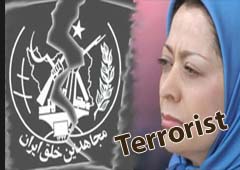The head of an Iranian exile group holed up at a camp in Iraq said Wednesday that the first of the camp’s residents are ready to move to a new location picked by the Iraqi government, solving a potential crisis.

The announcement Wednesday by Maryam Rajavi, the Paris-based leader of the group, averted what could have been a bloody showdown with Iraqi authorities if the residents had refused to move.
“After receiving assurances … and as a sign of goodwill, 400 Ashraf residents are ready to go to Camp Liberty with their moveable property and vehicles at first opportunity,” read the statement. Camp Liberty is the former American military base in Baghdad that has been chosen as the group’s new home.
The agreement comes as militants this week twice tried to target the camp with rockets. No one was injured.
The Iraqi government vowed to close Camp Ashraf, home to about 3,400 Iranian exiles, by the end of this year. The exiles, members of the People’s Mujahedeen Organization of Iran, one-time allies of Saddam Hussein in a common fight against Iran, favor the overthrow of the Iranian government.
But since the ouster of Saddam they have become an irritant to an Iraqi government that is trying to establish good ties with Iran and sees the group as an affront to Iraqi sovereignty. At least 34 people were killed in April during an Iraqi government raid on the camp.
The United Nations on Sunday announced an agreement to move the residents of Camp Ashraf to a temporary location, but until Wednesday, the exiles had not said whether they would go.
Rajavi said 400 residents are ready to move first as a sign of goodwill. The statement made no mention of when the other residents would go, but the group’s residents are believed to want to stay together. If the first move is successful and safe, it’s likely the rest would be relocated soon.
“The transfer of the first group of residents is a test of the Iraqi Government’s attitude in respecting obligations as professed to the U.N. and U.S.,” Rajavi said.
At Camp Liberty, the U.N.’s refugee agency will interview the residents to determine their eligibility for refugee status, before they can eventually be resettled in third countries. Returning to Iran is ruled out because of their opposition to the regime.
Rajavi’s statement also gave rare insight into a camp that was built during the 1980s and has largely been closed off to the outside world. The group’s residents have not left the camp for years, and the little contact they have with outsiders is through the Iraqi military, visiting diplomats and aid agencies. They do have extensive communications equipment that allows them to communicate with the outside world.
The group’s leader said residents had taken a piece of land in the desert and transformed it into a “modern city with their labor and extensive cost.”
“It has a university, library, museum, hospital, power station, cemetery, mosque, parks, lake, sports and recreation facilities, and underground bomb shelters,” she said.
The group carried out a series of bombings and assassinations against Iran’s regime in the 1980s and fought alongside Saddam’s forces in the Iran-Iraq war. The group says it renounced violence in 2001. U.S. soldiers disarmed them during the invasion of Iraq in 2003.
Under the agreement outlined by the U.N., the international organization will monitor the relocation process, and then a team from the U.N.’s refugee agency will be deployed at the new location to process the refugee claims. The U.S. has said that its embassy personnel will also frequently check on the camp’s residents.

